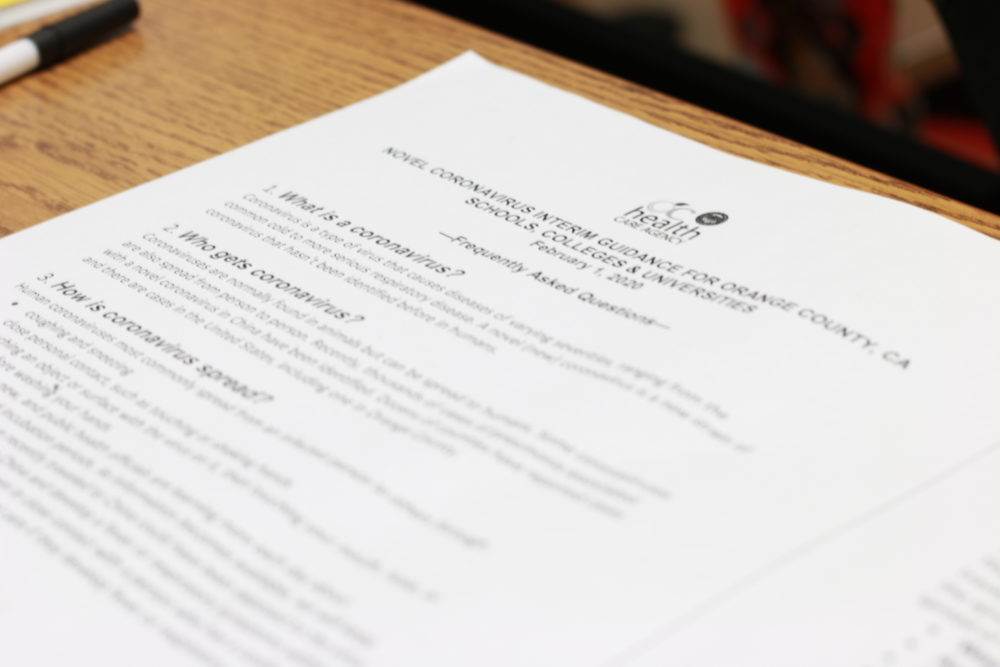
By Katy Nguyen
The first United States case of a novel (new) coronavirus thought to have originated from a seafood market in Wuhan, China was confirmed in Washington state less than two weeks ago, and the disease has since spread to Arizona, California, Illinois and Massachusetts for a total of 14 cases in the U.S.
Over the course of two weeks, Chinese health officials and the World Health Organization (WHO) have confirmed that the disease has escalated to over 45,000 cases globally, all but 393 of which are from mainland China. The other 393 confirmed cases have occurred in Asia, Europe and North America, most of whom were travelers from the epidemic center. This coronavirus has left 1,113 dead in China, three times more than the 2003 outbreak of Severe Acute Respiratory Syndrome (SARS), which was caused by a different strain of coronavirus.
The WHO has declared a “public health emergency of international concern,” on Jan. 30, as the virus continues to grow exponentially by the day.
This strain of the coronavirus, now known as COVID-19, is a disease that infects the respiratory system. Symptoms can include fever, cough, shortness of breath and pneumonia. The Center for Disease and Control Prevention (CDC) believes that the symptoms, which surface around two to 14 days after infection, can go unnoticed.
Scientists believe that COVID-19 is transmitted by person-to-person contact, although the disease was originally thought to have occurred in a seafood and poultry market.
WHO authorities suggested the new official name COVID-19, an acronym for Coronavirus Disease 2019, on Feb. 11. WHO Director-General Tedros Adhanom Ghebreyesus stated that their goal was avoid stigma with the new name by including no association with a geographic location.
As shortages of medical supplies rush in, there has been a fear about how the virus would be contained, which officials still remain unclear about. This shortage poses a serious threat to medical facilities that are in need of such materials to treat quarantined patients.
Local CVS pharmacies have stated that all their face masks have been sold out in the areas surrounding Huntington Beach.
The Orange County Health Department states, “risk of infection to the public in Orange County is believed to be low.”
On Jan. 31, the Department of Health and Human Services (HHS) declared this coronavirus as a public health emergency in the United States and will quarantine all of those returning from areas with high infection rates. Orange County’s John Wayne Airport is not among the quarantine sites.
Fountain Valley High School policies, according to nurse Marci Mclean-Crawford (Nurse Marci), does not suggest anything about wearing face masks, however supervision may ask students to remove them for identification purposes.
“Always remember to wash your hands frequently, wipe down desks (I have microfiber cloths in my office if anyone wants some), avoid touching your face with your hands, and cover coughs and sneezes,” Nurse Marci recommended in an email.
WHO suggests precautions such as avoiding close contact with those who have respiratory infections, avoiding contact with wild animals, practicing frequent hand washing, and practicing cough etiquette to avoid infecting others.
This is an ongoing story.
Update Feb. 25:
COVID-19 now has 81,600 confirmed cases worldwide and 2,760 people have died, only 45 of those are not from China.
South Korea has risen to 1,146 cases with 10 deaths. The CDC recommends to avoid traveling to China and South Korea.
Italy has become the first European country infected with 322 cases and 10 deaths.
Many U.S. citizens infected on the Diamond Princess cruise shipped have returned and are quarantined at military bases or hospitals.





